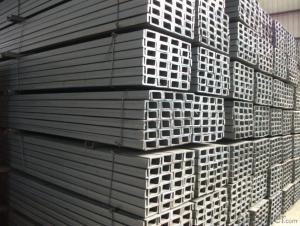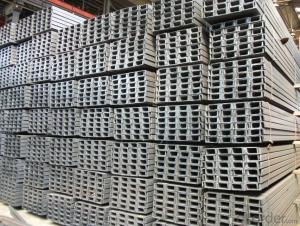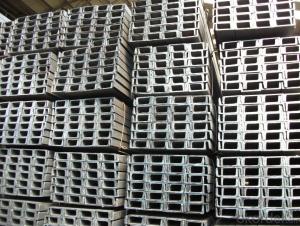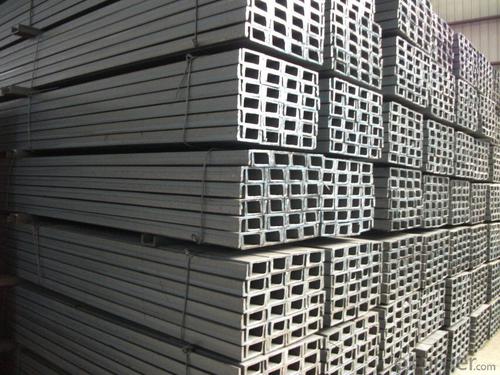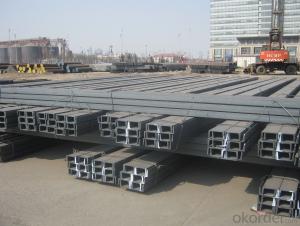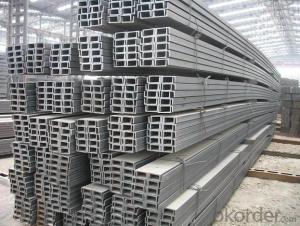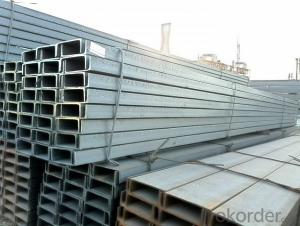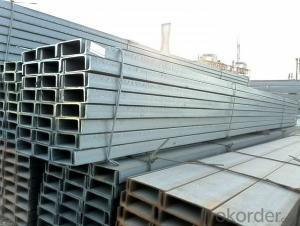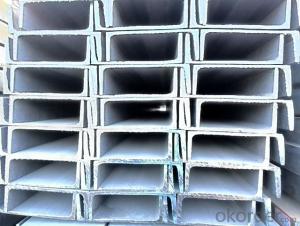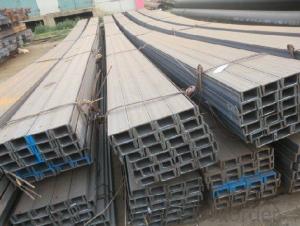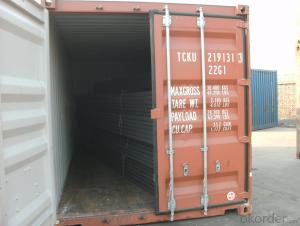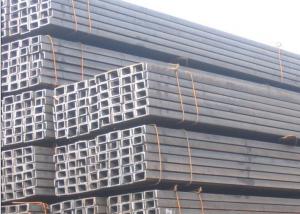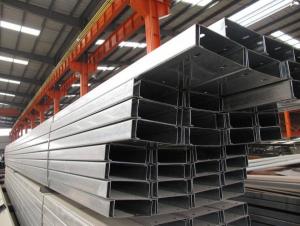U-Channels Source from China Market with Best Price
- Loading Port:
- Tianjin
- Payment Terms:
- TT OR LC
- Min Order Qty:
- 25 m.t
- Supply Capability:
- 10000 m.t/month
OKorder Service Pledge
OKorder Financial Service
You Might Also Like
Specification
OKorder is offering high quality Hot Rolled U-Channels at great prices with worldwide shipping. Our supplier is a world-class manufacturer of steel, with our products utilized the world over. OKorder annually supplies products to European, North American ,Africa and Asian markets. We provide quotations within 24 hours of receiving an inquiry and guarantee competitive prices.
Product Applications:
Hot Rolled U-Channels are ideal for structural applications and are widely used in the construction of buildings and bridges, and the manufacturing, petrochemical, and transportation industries.
Product Advantages:
OKorder's U-Channels are durable, strong, and resist corrosion.Most important ,our price is evry competitive.
Main Product Features:
· Premium quality
· Prompt delivery & seaworthy packing (30-45 days after receiving deposit)
· Corrosion resistance
· Can be recycled and reused
· Mill test certification
· Professional Service
· Competitive pricing
Product Specifications:
Manufacture: Hot rolled
Grade: Q235/SS400
Certificates: ISO, SGS, BV, CIQ
Length: 6m – 12m, as per customer request
Packaging: Export packing, nude packing, bundle
JIS U CHANNEL | Standard | Sectional | Dimension |
| Mass: |
(mm) | (mm) | (mm) | (mm) | ||
50x25 | 50 | 25 | 3.0 | 6.00 | 2.37 |
75X40 | 75 | 40 | 3.8 | 7.00 | 5.30 |
75X40 | 75 | 40 | 4.0 | 7.00 | 5.60 |
75X40 | 75 | 40 | 4.5 | 7.00 | 5.85 |
75X40 | 75 | 40 | 5.0 | 7.00 | 6.92 |
100X50 | 100 | 50 | 3.8 | 6.00 | 7.30 |
100X50 | 100 | 50 | 4.2 | 6.00 | 8.03 |
100X50 | 100 | 50 | 4.5 | 7.50 | 8.97 |
100X50 | 100 | 50 | 5.0 | 7.50 | 9.36 |
125X65 | 125 | 65 | 5.2 | 6.80 | 11.66 |
125X65 | 125 | 65 | 5.3 | 6.80 | 12.17 |
125X65 | 125 | 65 | 5.5 | 8.00 | 12.91 |
125X65 | 125 | 65 | 6.0 | 8.00 | 13.40 |
150x75 | 150 | 75 | 5.5 | 7.30 | 14.66 |
150x75 | 150 | 75 | 5.7 | 10.00 | 16.71 |
150x75 | 150 | 75 | 6.0 | 10.00 | 17.90 |
150x75 | 150 | 75 | 6.5 | 10.00 | 18.60 |
150x75 | 150 | 75 | 6.5 | 10.00 | 24.00 |
200X80 | 200 | 80 | 7.5 | 11.00 | 24.60 |
FAQ:
Q1: Why buy Materials & Equipment from OKorder.com?
A1: All products are carefully selected from China's most reliable manufacturing enterprises. Through its ISO certifications, OKorder.com adheres to the highest standards and a commitment to supply chain safety and customer satisfaction.We can guarantee the quality!
Q2:What's your payment terms ?
A2: We can accecpt T/T,LC at sight and time LC.
Q3: You selling on theoretical weight basis or actual weight basis ?
A3: Yes, we can do both ,deponding on buyers' needs .
Images

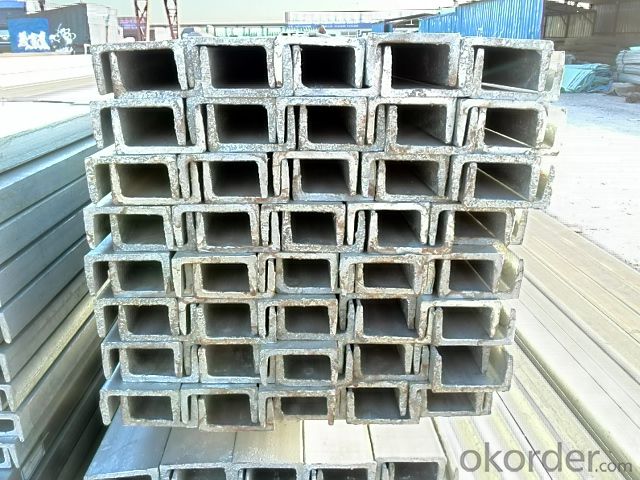
- Q: What are the different surface finishes available for steel channels in architectural applications?
- In architectural applications, steel channels have multiple surface finish options available. These finishes are applied to improve the steel channels' appearance, durability, and resistance to corrosion. Some commonly used surface finishes for steel channels in architectural applications include the following: 1. Mill finish: This is the initial finish obtained after manufacturing the steel channel. It has a rough, untreated surface and may have visible imperfections. Mill finish is suitable for situations where the steel channel will be covered or painted. 2. Galvanized finish: The galvanizing process involves applying a protective zinc coating to the steel channel to prevent corrosion. This finish offers excellent corrosion resistance and is commonly used in outdoor applications or environments with high humidity or chemical exposure. 3. Powder coating: In this dry finishing process, a fine powder is electrostatically applied to the steel channel and then cured under heat. Powder coating provides a durable and smooth surface with a wide range of color options. It is often used for decorative purposes and to provide additional corrosion protection. 4. Brushed finish: The brushing process involves using a wire brush to create a fine texture on the surface of the steel channel. This finish gives the steel channel a brushed or satin appearance and is popular for architectural applications that require a more refined look. 5. Polished finish: Polishing includes mechanical or chemical treatments to achieve a smooth and reflective surface on the steel channel. This finish is commonly used for decorative purposes and can create a luxurious, high-end appearance. 6. Painted finish: Steel channels can also be painted with various coatings to enhance their aesthetic appeal and protect against corrosion. Painted finishes offer a wide range of color options and can be customized to match the design requirements of the architectural application. The choice of surface finish for steel channels in architectural applications depends on factors such as the desired appearance, level of corrosion resistance required, and specific environmental conditions the steel channels will face.
- Q: Channel 10 is calculated, if the price per metre is calculated
- When choosing, we can know the gap between the channel and the national standard through weighing. The weight difference is different, the price also has the difference. If calculated, the greater the negative difference, the lower the offer. For example, the current market in Guangxi minus 10% of the 10 steel, according to the theory, the offer is probably 5000 yuan / ton, that is, 50 yuan / meter.
- Q: How do steel channels perform under wind loads?
- Steel channels are commonly used in construction and engineering projects to provide structural support and stability. When it comes to wind loads, steel channels perform exceptionally well due to their strength and rigidity. Steel channels have high tensile strength, which means they can resist the forces exerted by wind loads without undergoing significant deformation or failure. Wind loads can create both uplift and lateral forces on structures, and steel channels are designed to effectively distribute and transfer these forces to the foundation or other structural elements. The shape and cross-sectional design of steel channels also contribute to their performance under wind loads. The profile of a steel channel allows it to efficiently dissipate the wind's energy, reducing the chances of structural damage or failure. The open design of steel channels also helps to minimize wind resistance, further enhancing their ability to withstand wind loads. Moreover, steel channels can be customized and engineered to meet specific wind load requirements for different geographical locations. By considering factors such as wind speed, direction, and exposure, engineers can determine the appropriate size, shape, and spacing of steel channels to optimize their performance under wind loads. In summary, steel channels are highly reliable and efficient in withstanding wind loads. Their high tensile strength, shape, and customization options make them an ideal choice for structures that are exposed to strong winds. Whether it is a bridge, building, or any other construction project, steel channels provide the necessary support and stability to withstand wind loads and ensure the structural integrity of the overall system.
- Q: Channel 12, span 5 meters, how much weight can be carried?
- Check the ordinary channel capacity should be B (i.e. limited channel material can only bear much of the force, this is the state), because the common channel is Q235 type steel structure, the allowable stress of [b]=1400kg/c square meters
- Q: Are steel channels suitable for use in the construction of equipment frames?
- Yes, steel channels are suitable for use in the construction of equipment frames. Steel channels, also known as C-channels or U-channels, are commonly used in the construction industry due to their strength, durability, and versatility. They provide excellent structural support and stability, making them ideal for equipment frames. Steel channels are made from high-quality steel, which offers superior strength and load-bearing capacity. This makes them capable of withstanding heavy loads and providing a stable platform for equipment. Additionally, steel channels have excellent resistance to bending, twisting, and warping, ensuring that the equipment frame remains sturdy and reliable. Furthermore, steel channels come in various sizes and thicknesses, allowing for customization to suit specific equipment requirements. They can be easily cut, welded, and shaped to fit the desired frame design. This flexibility in design and construction makes steel channels an attractive choice for equipment frames, as they can be tailored to meet the specific needs of the equipment being supported. In terms of cost-effectiveness, steel channels offer a great value for money. They have a long lifespan and require minimal maintenance, making them a durable and cost-efficient option. Steel is also a recyclable material, making it an environmentally friendly choice for construction projects. Overall, steel channels are highly suitable for use in the construction of equipment frames. Their strength, durability, versatility, and cost-effectiveness make them an excellent choice for supporting and securing equipment in various industries.
- Q: Can steel channels be used for balcony supports?
- Certainly! Balcony supports can indeed utilize steel channels. In the realm of construction and engineering, steel channels are a popular choice due to their robustness and longevity. They offer exceptional structural reinforcement and are particularly well-suited for balconies. By employing adequate design and installation techniques, steel channels can effectively withstand the weight and burden of a balcony, ensuring its steadfastness and security. It is essential to seek guidance from a structural engineer or an experienced contractor to identify the precise dimensions and specifications of the steel channels needed for a given balcony design and load necessities.
- Q: What are the different weight classifications for steel channels?
- The weight classifications for steel channels vary depending on the specific dimensions and designations, but common weight classifications include lightweight, medium weight, and heavy weight.
- Q: How do steel channels contribute to the durability of a structure?
- Steel channels contribute to the durability of a structure in several ways. Firstly, steel channels are made from a high-strength material which provides excellent resistance to external forces. This means that they can withstand heavy loads, impacts, and vibrations without deforming or breaking, ensuring the structural integrity of the building. Secondly, steel channels are designed with specific shapes and dimensions, allowing them to distribute the loads evenly across the structure. This helps in preventing localized stress concentrations, reducing the risk of fatigue failure over time. By evenly distributing the forces, steel channels can also minimize the potential for cracks or structural deformations, enhancing the long-term durability of the structure. Furthermore, steel channels offer superior corrosion resistance compared to other materials like wood or concrete. Steel is often protected with coatings or galvanized to prevent rust and corrosion, which can significantly extend the lifespan of the structure. This resistance to corrosion is particularly important in environments with high humidity, exposure to saltwater, or industrial pollutants. Another advantage of steel channels is their versatility and adaptability in construction. They can be easily fabricated and customized to fit the specific needs of a structure, including size, shape, and connection details. This flexibility allows for efficient construction and the ability to modify or expand the structure in the future without compromising its overall durability. Lastly, steel channels offer fire resistance, which is crucial for the safety and durability of a structure. Steel has a high melting point and does not contribute to the spread of fire, providing valuable time for occupants to evacuate and minimizing damage to the building. This fire resistance also reduces the need for extensive fireproofing measures, making steel channels a cost-effective solution for enhancing the durability of a structure. In summary, steel channels contribute to the durability of a structure by providing high-strength, even load distribution, corrosion resistance, versatility, and fire resistance. These qualities help ensure the longevity and safety of the building, making steel channels a valuable component in construction.
- Q: Are steel channels suitable for structural applications?
- Yes, steel channels are suitable for structural applications. Steel channels are commonly used in the construction industry for structural purposes due to their strength and durability. They provide excellent load-bearing capabilities, making them ideal for supporting heavy loads and spanning long distances. Steel channels also have good resistance to bending and twisting forces, which enhances their structural integrity. Additionally, steel channels can be easily fabricated and welded, allowing for a wide range of design possibilities. Overall, steel channels offer a reliable and cost-effective solution for various structural applications, including building frames, bridges, and industrial structures.
- Q: How do steel channels perform under dynamic loads?
- Steel channels are known for their high strength and load-bearing capacity, making them well-suited for handling dynamic loads. When subjected to dynamic loads, such as vibrations, impacts, or fluctuating forces, steel channels exhibit excellent performance and durability. The structural design of steel channels allows them to effectively distribute dynamic loads throughout their length, preventing localized stress concentrations. This characteristic minimizes the risk of fatigue failure, which is crucial in applications where repeated loading occurs. Steel channels also possess good stiffness, which helps to maintain their shape and integrity under dynamic loads. This stiffness allows them to resist bending, twisting, or deforming, ensuring the overall stability and safety of the structure. Additionally, steel channels are highly ductile, meaning they can withstand significant deformation without fracturing. This ductility is essential in absorbing and dissipating energy during dynamic loading events, such as impacts or earthquakes, reducing the risk of catastrophic failure. Furthermore, steel channels are often used in conjunction with other structural components, such as bolts, welds, or connectors, to enhance their load-bearing capacity. The combination of steel channels with these reinforcements further improves their performance under dynamic loads by increasing their resistance to shear, torsion, and bending forces. In summary, steel channels are well-suited for handling dynamic loads due to their high strength, excellent load distribution capabilities, stiffness, ductility, and compatibility with reinforcements. These qualities make them a reliable choice for various applications that require withstanding dynamic forces, ensuring the durability and safety of the structures they are used in.
Send your message to us
U-Channels Source from China Market with Best Price
- Loading Port:
- Tianjin
- Payment Terms:
- TT OR LC
- Min Order Qty:
- 25 m.t
- Supply Capability:
- 10000 m.t/month
OKorder Service Pledge
OKorder Financial Service
Similar products
Hot products
Hot Searches
Related keywords
